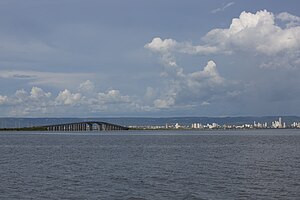| Tocantins River | |
|---|---|
 Tocantins River and Fernando Henrique Cardoso bridge | |
 Map of the Araguaia/Tocantins Watershed | |
| Native name | Rio Tocantins (Portuguese) |
| Location | |
| Country | Brazil |
| Physical characteristics | |
| Source | Serra da Mesa Reservoir |
| • location | Minaçu, Goiás |
| • coordinates | 13°50′03″S 48°18′16″W / 13.83417°S 48.30444°W |
| • elevation | 443 m (1,453 ft) |
| Mouth | Marajó Bay |
• location | Igarapé-Miri, Pará |
• coordinates | 1°45′S 49°10′W / 1.750°S 49.167°W |
• elevation | 0 m (0 ft) |
| Length | 2,640 km (1,640 mi) |
| Basin size | 764,183 km2 (295,053 sq mi) |
| Discharge | |
| • location | mouth |
| • average | 11,796 m3/s (416,600 cu ft/s) |
| Basin features | |
| River system | Tocantins basin |
| Tributaries | |
| • left | Paranã, Sono River |
| • right | Araguaia River, Itacaiúnas River |
The Tocantins River (Portuguese: Rio Tocantins Portuguese pronunciation: [ˈʁi.u tokɐ̃ˈtʃĩs, tu-], Parkatêjê: Pyti [pɨˈti])[1]: 59 is a river in Brazil, the central fluvial artery of the country. In the Tupi language, its name means "toucan's beak" (Tukã for "toucan" and Ti for "beak"). It runs from south to north for about 2,450 km (1,520 mi). While sometimes included in definitions of the Amazon basin, the Tocantins is not a branch of the Amazon River, since its waters flow into the Atlantic Ocean via an eastern channel of the Amazon Delta, alongside those of the Amazon proper. It flows through four Brazilian states (Goiás, Tocantins, Maranhão, and Pará) and gives its name to one of Brazil's newest states, formed in 1988 from what was until then the northern portion of Goiás.
The Tocantins is one of the largest clearwater rivers in South America.[2]
- ^ a b Araújo, Leopoldina (2019). Romanço Parkatêjê. Belém. ISBN 978-85-910871-4-3.
{{cite book}}: CS1 maint: location missing publisher (link) - ^ Perez, M.S. "Where the Xingu Bends and Will Soon Break". American Scientist. Retrieved 1 October 2017.